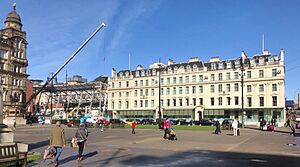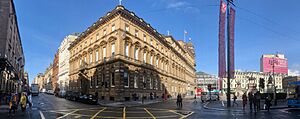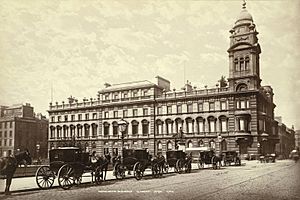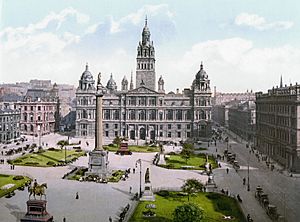George Square facts for kids

George Square (Scottish Gaelic: Ceàrnag Sheòrais) is a very important public square in the city of Glasgow, Scotland. It is one of six main squares in the city centre.
Named after King George III, the square was first planned in 1781. It is surrounded by impressive buildings. On the east side, you can see the grand Municipal Chambers, also known as the City Chambers. Its foundation stone was laid in 1883. On the west side is the Merchants’ House. The City Chambers are still the main offices for the Glasgow City Council.
George Square is also famous for its many statues and monuments. These include statues of famous people like Robert Burns, James Watt, Sir Robert Peel, and Sir Walter Scott.
Contents
How George Square Grew Over Time
From Pasture to City Square
Long ago, in medieval Glasgow, the area where George Square now stands was a large open field. It was used as a common pasture where townspeople would take their cattle to graze. There was a simple dirt road called Cow Lone that led to these fields.
As Glasgow grew richer from trade in tobacco, sugar, and cotton, the city began to expand. New streets were planned and built. In 1766, Cow Lone was paved and renamed Queen Street after Queen Charlotte.
Planning the Square
In 1781, city planners created a design for a large square. This plan helped guide how new buildings would be constructed around it. In 1782, the first house for two families was built in George Square. After a short pause, the area began to grow quickly.
Around 1790, the new developments north of the Trongate area became known as Glasgow's New Town. George Square was named after King George III.
Early Buildings and Changes
Between 1787 and the 1820s, elegant Georgian buildings were constructed around George Square. These included three-storey blocks of homes on the west side and two-storey homes on the east. Hotels also started to appear. By 1804, people were already saying that the buildings, especially on the north side, were very beautiful and impressive.
In 1819, the first statue was put up in the square. It honored Sir John Moore, a military officer.
In 1825, the city decided to improve the square. They added winding paths, trees, and shrubs, and put up an iron fence. The square became a lovely place for walks and even hosted flower shows. The most famous monument, an 80-foot tall column, was built in the center to honor author Sir Walter Scott. It was finished by 1837.
The Arrival of the Railway
In 1838, a large mansion near the square was bought by the Edinburgh and Glasgow Railway company. They tore it down to build their train station, which opened in 1842. This station later became known as Queen Street Station. Its main entrance is a direct continuation of Queen Street.
Over time, many of the grand houses around the square were turned into hotels to welcome travelers. One famous hotel was Cranston's Hotel, run by the family of Kate Cranston, who later became famous for her Tea Rooms.
New Buildings and City Management
In the mid-1800s, new buildings replaced some of the older terraces. The Bank of Scotland built an impressive Italian-style building between 1867 and 1870. The Merchants' House was also built during this time, between 1875 and 1880.
In 1862, the Glasgow Corporation (the city's government) took over managing George Square. In 1878, the square's iron railings were removed, and new paths and flower beds were added.
The grand Glasgow City Chambers were built on the east side of the square. Construction began in 1883 and was completed in 1889. This building became the main headquarters for the city council.
The Queen's Hotel on the north side of the square became the North British Station Hotel in 1905. It was later renamed the Millennium Hotel and is now a listed building, meaning it is protected because of its historical importance.
More recently, Queen Street Station underwent major reconstruction. Its old buildings along George Square were taken down, and a new glass entrance from the square began construction in December 2018. This work was completed, and the station now has a modern look.
Important Buildings Around the Square
Today, the east side of George Square is dominated by the beautiful Glasgow City Chambers. This ornate building, designed by William Young, was finished in 1889. It is where the Glasgow City Council holds its meetings and does its work.
On the south side, you can find the former General Post Office, built in 1878. This building was redeveloped into offices in 2007.
The north side of the square features the entrance to Queen Street Station. Next to it is the Millennium Hotel, which was originally a terrace of three townhouses built between 1807 and 1818.
On the west side of the square is the Merchants' House building. This building belongs to a group called the guildry, which was formed in 1603 to support Glasgow's merchants and craftspeople. The building also houses the Glasgow Chamber of Commerce, which started in 1783. The Merchants' House has a unique domed tower with a ship on a globe, reminding everyone of how important sea trade was for Glasgow's success.
Statues and Monuments
George Square is like an outdoor museum because of its many statues and monuments.
On the eastern side, you will find the Glasgow Cenotaph. This monument was built to remember the people from Glasgow who lost their lives in the First World War. It was unveiled in 1924.
In the very center of the square stands an 80-foot tall column honoring the famous author Sir Walter Scott. This monument was put up in 1837.
Around the square, there are eleven other public statues. These include:
- Two equestrian (on horseback) statues of a young Queen Victoria (1865) and her husband Prince Albert (1866).
- Statues of poets Robert Burns (1877) and Thomas Campbell (1877).
- A statue of the inventor James Watt (1832).
- A statue of the chemist Thomas Graham (1872).
- Statues of military leaders Sir John Moore (1819) and Lord Clyde (1868).
- Statues of politicians William Ewart Gladstone (1902), Robert Peel (1859), and James Oswald (1856).
George Square's Role in History and Today
George Square is not just a pretty place; it has also been a stage for many important events. It hosts musical events, light shows, and ceremonies. It is also a place for sporting celebrations and annual Remembrance Day parades.
Famous Gatherings and Protests
The square has often been a place for people to gather and express their views. One of the most well-known events was in 1919. Many skilled workers gathered in the square to ask for a shorter working week. This large gathering led to some clashes between the protesters and the police. To help keep order, soldiers were sent to Glasgow, though the main events were over by the time they arrived.
Modern Use and Changes
In February 2005, the square was closed for a two-month project to clean the stone and statues. The red asphalt paths were also replaced.
In August 2011, scenes for the zombie movie World War Z were filmed in the square. The buildings around George Square looked similar to parts of Philadelphia, which was perfect for the movie.
There have been discussions about changing the square. In 2012, the Glasgow City Council planned a "makeover" for the square before the 2014 Commonwealth Games. These plans included possibly moving some of the statues for restoration. However, many people in Glasgow did not want the statues to be moved. Because of this public opposition, the council leader announced that the redevelopment plan was cancelled. The statues remained in their places.
See also
 In Spanish: George Square para niños
In Spanish: George Square para niños












